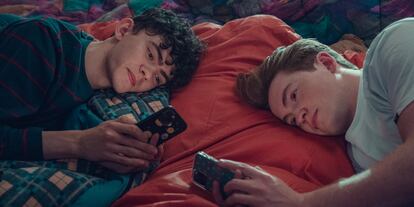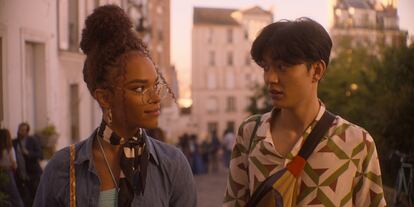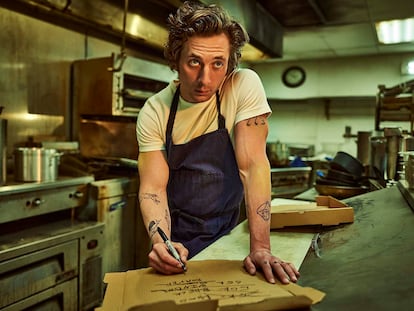‘Heartstopper’: the most luminous series of our times gets dark
The second season of the Netflix series has been released. The show follows the love life of a gay teenager and his bisexual classmate, while delving into the mental health of the characters

While other TV series reflect adolescence as a period of life wracked by drama and constant emotional torment, Heartstopper chooses light and color. And, unlike the inconsequential romances of many youth productions, this show opts for vindication and mental health treatment.
The Netflix series might seem like just another high school story, but it has made an effort to be different. It’s a celebration of diversity, doing more than simply telling the story of the romantic relationship between a gay boy and his bisexual classmate, who are discovering their sexual orientations.
In the circle of friends, there’s a lesbian couple, a trans girl and a cisgender boy, who are engaged in a romantic tug of war. Things aren’t easy for any of them. Added to the dramas of adolescence is the complexity of a world that doesn’t always welcome them. But Heartstopper chooses to have its characters inhabit a world of color and optimism, while not hiding the fact that they coexist with the darkness. The second season recently released on Netflix puts an emphasis on the latter.
The on-screen love story of Charlie and Nick is the adaptation of a comic written and drawn by 28-year-old Alice Oseman, who hails from the town of Chatham in the United Kingdom.
“Dark stories about queer characters that explore trauma — which are more mature and adult in tone — are really important. I enjoy watching them. But, at the same time, we do need joyful stories as well, and we need stories that are accessible for younger viewers. I think, at the end of the day, we just need a variety of different kinds of queer TV shows,” Oseman tells EL PAÍS.
In an interview via video call on August 2, the British creator — who is also a scriptwriter for the series — explains the complexities of putting together the second season of a show that, in its first installment, became a cult phenomenon. “Writing the second part of anything — a sequel, a new music album, whatever — is more difficult. There’s a lot of pressure from the fans. The most difficult thing has been creating plotlines that aren’t in the comics, [because I try] to stick very closely to the core story of the books. It’s quite difficult, but I’ve tried my very best to create something that, I think, most people are going to really, really enjoy.”

Heartstopper goes beyond the central love story and the relationships that arise around it. This becomes clearer in a second season, which sees the cast travel to Paris and Nick begin to come out of the closet. The show delves into the mental health problems of the characters, as well as their insecurities and doubts. For example, Nick is increasingly concerned about his eating disorder, while haunted by how his boyfriend bullied him in the past.
Mental health was one of the core issues that Alice Oseman wanted to address in her stories, while celebrating the joy of different kinds of love. “This is a story about mental health, [something that] becomes particularly apparent in season two. There were already hints in the first season, but now we face it directly. Nick and Charlie have to learn [about each other] and understand each other better, to know how to deal with each other’s mental health. We started that journey in the second season, and it will be a big element of season three as well,” the writer notes. She sees it as a challenge to combine the luminosity of her colorful series with darker subjects.
Born in 2016 as a webcomic, the success of Heartstopper eventually surpassed its author. The web edition grew in popularity, after which it jumped to the paper version and, from there, to the screen with Netflix. “At first, it was just something I did for fun. And now it’s my entire job. It’s literally the only thing that I’ve been working on for the past few years and will probably be the only thing I’m working on for the next couple of years at the very least. It has completely changed my life.”
When asked about the possible reasons for the success of her story, she points to several reasons, but one above all: “People love joyful stories. I think that’s kind of proven across so many different shows that have blasted to popularity, like Bridgerton or Sex Education — those are both sort of upbeat, happy, cheerful shows at their core. And people really want that kind of content, I think, especially in times like this.”
“I think Heartstopper — although it’s made with teenagers in mind — still really appeals to people of all ages,” Oseman notes. “We’ve had a lot of responses from adults who have watched it and really connected to it. That’s really special. I truly believe that we made a good adaptation of a book, which doesn’t always happen.”

For this to have happened, it was key to have a good cast. Achieving this wasn’t easy, as Oseman explains. “There were so many different factors that we needed to consider. You know, we wanted them to look like the drawings. We wanted them to be around the right age. The [actors who portray] Nick and Charlie actors needed to have chemistry with each other, otherwise the show just wasn’t going to work.”
In a casting process that the writer describes as “intense and a bit of a nightmare,” the production team ultimately found “the perfect person for each role.”
“We only had one actor for each character; there were no backup options, [since it was] extremely difficult to find each one.” Out of that process came Joe Locke and Kit Connor as Charlie and Nick. “What surprised me the most about them was their emotional intelligence. They’re not afraid to push emotional scenes to the limit and dive into Charlie and Nick’s feelings. It’s a teen romance, and it could easily be very cheesy and silly in the hands of the wrong actor, but Kit and Jo took it so seriously; you can feel how much they love playing Nick and Charlie.”
Now that Heartstopper is a global phenomenon, the attention that Oseman’s comic receives has multiplied. There’s a fan-driven obsession around her creations, which has led Oseman to distance herself from the reactions on the internet. “Most of the fans of Heartstopper are really nice, and they just want to chat about the story. But in any fandom, there are always going to be some unpleasant characters. You just have to kind of learn how to take a step back from that, which was quite hard for me, because I had a really close connection with the fan base. When Heartstopper was quite small, I was able to talk to readers a lot of the time, reply to comments… I would read all of them. And now, that’s really just impossible. It would also be very bad for my mental health if I did that.”

Oseman speaks calmly and with a constant smile — an attitude that suits her creation well. She already knows how Heartstopper will end: the television version has been renewed for a third season, while the fifth volume of the comic book will be published in December. “I’ve thought about the ending, yes. I know how Nick and Charlie’s story will end… but as for the other characters, I haven’t quite figured out what’s going to happen to them. We’ll see.”
Sign up for our weekly newsletter to get more English-language news coverage from EL PAÍS USA Edition
Tu suscripción se está usando en otro dispositivo
¿Quieres añadir otro usuario a tu suscripción?
Si continúas leyendo en este dispositivo, no se podrá leer en el otro.
FlechaTu suscripción se está usando en otro dispositivo y solo puedes acceder a EL PAÍS desde un dispositivo a la vez.
Si quieres compartir tu cuenta, cambia tu suscripción a la modalidad Premium, así podrás añadir otro usuario. Cada uno accederá con su propia cuenta de email, lo que os permitirá personalizar vuestra experiencia en EL PAÍS.
¿Tienes una suscripción de empresa? Accede aquí para contratar más cuentas.
En el caso de no saber quién está usando tu cuenta, te recomendamos cambiar tu contraseña aquí.
Si decides continuar compartiendo tu cuenta, este mensaje se mostrará en tu dispositivo y en el de la otra persona que está usando tu cuenta de forma indefinida, afectando a tu experiencia de lectura. Puedes consultar aquí los términos y condiciones de la suscripción digital.
More information
Archived In
Últimas noticias
Most viewed
- Oona Chaplin: ‘I told James Cameron that I was living in a treehouse and starting a permaculture project with a friend’
- Reinhard Genzel, Nobel laureate in physics: ‘One-minute videos will never give you the truth’
- Sinaloa Cartel war is taking its toll on Los Chapitos
- Why the price of coffee has skyrocketed: from Brazilian plantations to specialty coffee houses
- Silver prices are going crazy: This is what’s fueling the rally











































